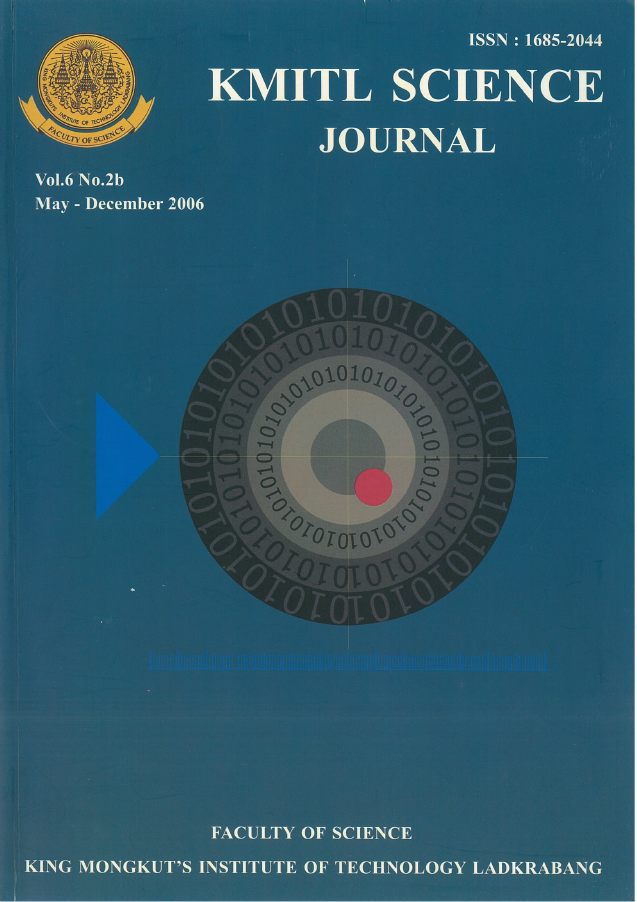Chemical Compounds, Anticancer and Antioxidant Activities of Volatile Oil from Piper sarmentosum Roxb., Polyscias fruticose Harms. And Polygonum odoratum Lour.
Main Article Content
Abstract
The volatile oils from fresh leaves of Piper sarmentosum Roxb., Polyscias fruticose Harms. and Polygonum odoratum Lour. Were isolated by hydrodistillation and analysed through a combination of gas chromatography-mass spectrometry (GC-MS). The essential oils were obtained in 0.0124, 0.1384 and 0.0567% yield, respectively. All volatile oils exist as a yellow liquid. The major constituents of Piper sarmentosum Roxb. were β-caryphyllene (42.51%), α-selinene (11.27%), (+)-β-selinene (11.24%), β-elemene (10.85%) and α-humulene (6.99%). The identified constituents of Polyscias fruticose Harms. include α-bergamotene (20.25%), γ-elemene (15.28%), and germacrene d (13.29%). Two peaks with relative areas of 25.19% and 14.53%, respectively remained unidentified. The major constituents of Polygonum odoratum Lour. Were dodecanal (39.54%), decanal (21.14%), β-caryphyllene (10.10%), 1-tetradeconal (8.84%) and euparone (7.36%). In addition, the volatile oils from Polyscias fruticose Harms. and Polygonum odoratum Lour. Showed significant pharmacological effect (ED50 << 30µg/ml) to anticancer activity, while Piper sarmentosum Roxb. oil exhibited only weak cytotoxic effect (ED50 > 30 µg/ml), from primary screening tests with P388 (mouse lymphocytic leukemia) cells. Moreover, none of the components exhibited antioxidant activity (IC50 values of >> 100µg/ml) in a DPPH radical scavenging assay.
Keywords: GC-MS, Volatile oil, Piper sarmentosum Roxb., Polyscias fruticose Harms., Polygonum odoratum Lour., Anticancer, Antioxidant
Corresponding author: E-mail: t_chem@hotmail.com
Article Details
Copyright Transfer Statement
The copyright of this article is transferred to Current Applied Science and Technology journal with effect if and when the article is accepted for publication. The copyright transfer covers the exclusive right to reproduce and distribute the article, including reprints, translations, photographic reproductions, electronic form (offline, online) or any other reproductions of similar nature.
The author warrants that this contribution is original and that he/she has full power to make this grant. The author signs for and accepts responsibility for releasing this material on behalf of any and all co-authors.
Here is the link for download: Copyright transfer form.pdf
References
[2] Anchana, C., Aphiwat, T. and Nuansri, R., 2005. Screening of antioxidant activity and antioxidant compounds of some edible plants of Thailand, Food Chemistry, 92(3), 491-497.
[3] Thitima, R., Puttan, S., Kanchanawadee, S., Chanika, W., Phongpan, R., Phaopong, W. and Apichart, S., 2004. Chemical constituents and bioactivity of Piper sarmentosum, Journal of Ethnopharmacology, 93(2-3), 173-176.
[4] สถาบันการแพทย์แผนไทย, ผักพื้นบ้านภาคเหนือ. โครงการพัฒนาตำรา กรมการแพทย์ กระทรวงสาธารณสุข, กรุงเทพฯ, 2542.
[5] Vo, D.H., Satoshi, Y., Kazuhiro, O., Ryoji, K., Kazuo, Y., Nguyen, T.N. and Hoang, M.C., 1998. Oleanane saponins from Polyscias fruticose, Phytochemistry, 47(3), 451-457.
[6] Kai-Jin Wang, Ying-Jun Zhang and Chong-Ren Yang, 2005. Antioxidant phenolic compounds from rhizomes of Polygonum paleaceum, Journal of Ethnopharmacology, 96 (3). 483-487.
[7] Lee, J.P., Min, B.S., An, R.B., Na, M.K., Lee, S.M., Lee, H.K., Kim, J.G., Bae, K.H. and Kang, S.S. 2003. Stilbenes from the roots of Pleuropterus cilinervis and their antioxidant activities, Phytochemistry, 64(3), 759-763.
[8] L. Ömür Demirezer, Ayse Kuruüzüm-Uz, Isabelle Bergere, H. –J. Schiewe and Axel Zeeck, 2001. The structures of antioxidant and cytotoxic agents from natural source: anthraquinones and tannins from roots of Rumex patientia, Phytochemistry, 58(8), 1213-1217.
[9] Blois M.S, 1958. Nature, 181, 119-1200.
[10] Adams, 2001. R.P. Adams, Identification of essential oil components by gas-chromatography / quadrupole mass spectrometry, Allured, Carol Stream IL, UAS.
[11] Davies, N.W., 1990. Journal of Chromatography, 503, 1-24.
[12] Dool, V.D. and Kratz, P.D. 1963. A generalization of the retention index system including linear temperature programmed gas-liquid partition chromatography, Journal of Chromatography 11, 463-471.


